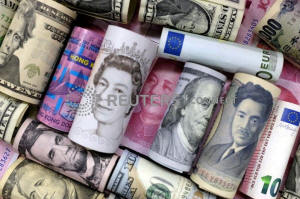Global currency funds notch wins amid coronavirus
volatility
 Send a link to a friend
Send a link to a friend
 [April 09, 2020] By
Gertrude Chavez-Dreyfuss [April 09, 2020] By
Gertrude Chavez-Dreyfuss
NEW YORK (Reuters) - Global currency fund
managers racked up gains in the first quarter as they benefited from the
extreme volatility that the coronavirus pandemic has stoked across
financial markets.
The BarclayHedge currency traders index was up 6.13% for the first three
months of the year and posted a 2.54% gain for March, according to data
the firm posted on Friday, showing results for 42% of the funds it
tracks.
By contrast, the S&P 500 fell 20% in the first quarter in its worst
quarterly decline since March 2009, while U.S. crude oil lost 66%.
Driving the gains in currency funds has been a surge in the market
swings that traders need to make money, as expectations of the worldwide
coronavirus-fueled slowdown prompted investors to move out of a broad
range of currencies and into the U.S. dollar.

The first quarter followed a long period of sleepy trading in currency
markets that had frustrated investors and shuttered numerous funds over
the years.
"March was a period of wild deleveraging, sharp reversals, and extreme
moves," said Richard Benson, co-chief investment officer at Millennium
Global Investments in London, with $18 billion in assets under
management.
Deutsche Bank's currency volatility index shot up to 16.36 on March 19,
its highest level since at least 2012. It now stands at 10.63. In
specific currency pairs, such as dollar/yen, the surge was even more
significant, hitting levels last seen in November 2008 in the midst of
the global financial crisis.
Many of the market's gyrations have hinged on moves in the U.S. dollar
and, to a lesser degree, other haven currencies such as the yen and
Swiss franc.
The dollar was the foreign exchange market's best performer in the first
quarter, notching gains of about 2.6% against a basket of major
currencies as economic slowdown fears pushed investors to sell assets
across the board and pile into cash.

[to top of second column] |

Euro, Hong Kong dollar, U.S. dollar, Japanese yen, pound and Chinese
100 yuan banknotes are seen in this picture illustration, January
21, 2016. REUTERS/Jason Lee/Illustration/File Photo

The dollar rose 1% last month despite a slew of measures from the Federal
Reserve to flood the financial system with greenbacks to address a liquidity
crunch caused in part by demand for U.S. currency.
The Swiss franc and the yen, two other popular destinations for nervous
investors, were up 3% and 1% respectively in the first quarter.
Other currencies saw deep losses. Sharp declines in prices for oil, metals, and
other raw materials sparked routs in commodity currencies like the Australian
dollar and Norwegian krone, which fell 12% and 18% in the first quarter,
respectively.
Declines in some emerging markets currencies at the end of the March were
particularly eye-popping. The Brazilian real fell 23% in the quarter while the
Mexican peso slid 20%.
"In periods like this, you should be long the U.S. dollar, the yen, and Swiss
franc and short everything with low liquidity like the Swedish krona, Norwegian
krona, and currencies close to global growth like the Australian and Canadian
dollars," said Momtchil Pojarliev, head of currencies at BNP Asset Management in
New York.
BNP Paribas Asset Management's currency program was also up in March, notching
1.5%-2% return on 5% volatility. Long positions in the U.S. dollar and Japanese
yen helped BNP's performance, Pojarliev said.

"If anyone has made money in this environment, it is by being risk averse quite
quickly," said Adrian Lee, president and chief investment officer at active
currency manager Adrian Lee & Partners, which oversees $12 billion in assets.
"To some extent, there was a very gradual response to all the information that
was coming out of China. So we went risk averse from the end of February and we
still are."
Lee and Millennium's Benson both said their funds gained in March.
(Reporting by Gertrude Chavez-Dreyfuss; Editing by Ira Iosebashvili and Tom
Brown)
[© 2020 Thomson Reuters. All rights
reserved.] Copyright 2020 Reuters. All rights reserved. This material may not be published,
broadcast, rewritten or redistributed.
Thompson Reuters is solely responsible for this content. |